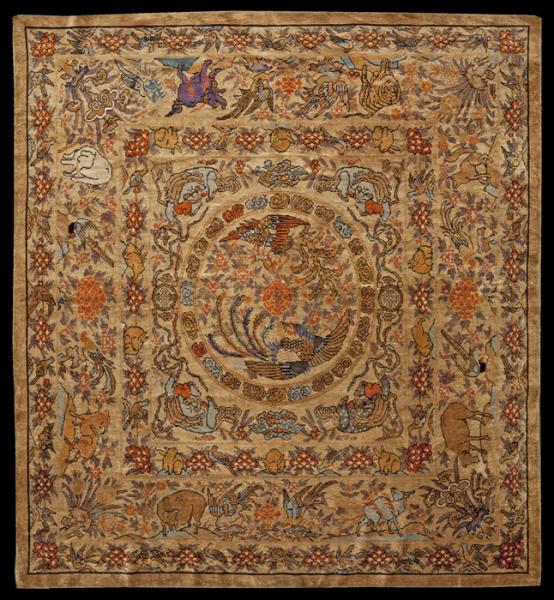Do you notice how this whole rug is like a game for the eyes?
What did the rug makers intend? I’m unsure, but this exceptionally fine, yet playful, silk rug hails from China around 1880. The square size of the rug may represent it having been used as a table carpet or meditation rug.
It conveys many little stories all within the same frame, using detail, characters, and the muted tones of blues, grays, oranges, and browns. Perhaps the animals depicted even helped anyone who sat on the rug meditate to an even deeper state. Let us enter the carnival of this rug.
The orange firework in the rug’s center is just like the sun—all else revolves around it. Two birds flank this flower, as if circling prey. Framing the birds are tawny, blue, and orange flowers.
Further out still, are hidden Shishi Lions. Also known as Guardian Lions or “Foo-Dogs” in the West, these mythical dog-like lions are loyal, and were believed to have powers of protection.
 Some believe that Chinese dog breeds such as Pugs and Chow-Chows may have been bred to look like them. In any case, it seems the ones in this rug are living up to their reputations, shielding some of the smaller animals from the bigger, scarier animals to come, such as the Tiger and the Purple Beast.
Some believe that Chinese dog breeds such as Pugs and Chow-Chows may have been bred to look like them. In any case, it seems the ones in this rug are living up to their reputations, shielding some of the smaller animals from the bigger, scarier animals to come, such as the Tiger and the Purple Beast.
The rug’s third border is a gentle world, where rabbits play, surrounded by little quails. Between each is a bouquet of orange and white flowers. And then, we have quite the menagerie. On the bottom left hand side, a purple flower sprouts towards the center.
Above that flower, a ram runs upwards. Lucky for him, he lives in a rug—in real life, gravity would present him with some problems.
Past him is a rooster, a larger quail, and a white elephant. Likely significant, such pachyderms were a key element in the Buddha story, as well as sacred in ancient cultures.
At the top left hand corner, we see more animals who are content to defy gravity. A regal bird sits, facing a purple creature of undetermined origin.
What is this creature’s name? I shall call him Han, in honor of “Han Purple”. After all, he was likely colored using with that very dye, employed in the decoration of China’s Terracotta Army sculptures.
As the only brightly colored animal here, clearly, Han clearly has a flair for the dramatic. This rug is a stage, and Han is a key player. Yet, what is he? A dragon? An elephant with a stunted trunk? Is he laughing, or roaring?
Two peacocks calmly sit to the right of him. On their right sits a tiger.
Hopefully for the peacocks’ sake, neither Han nor the tiger grow hungry.
On the top right hand corner, cascading flowers lead us to a fox. At first it seems that he is looking at a hen, but on closer inspection it is actually a fern.
That fox will be waiting a long time if he is expecting a meal. Below the fern and other flowers sit a peaceful pheasant and bull.
A strange couple, they are—I wonder why the pheasant is so calm and hasn’t flown away?
The bottom-right corner shows a flower bursting up towards the center, full of buds that almost give it the appearance of a Shishi Lion face. Next to it is a donkey, wrapped in red-vines.
Two pheasants and a bull sit to the donkey’s left—the bull calm, the pheasants with wings spread dramatically.
These pheasants apparently do not have an amiable relationship with their bovine, at least in comparison to the peaceful pheasant and bull above them.
Surrounding the pheasants, in the final, symmetrical border of the rug, are more quails, with the familiar orange and white petals.
What are your thoughts? Have you concocted a narrative for this carnival of animals? Perhaps you are too busy looking into Han and his fantastic, regal adventures.
See more rugs at www.dorisleslieblau.com











